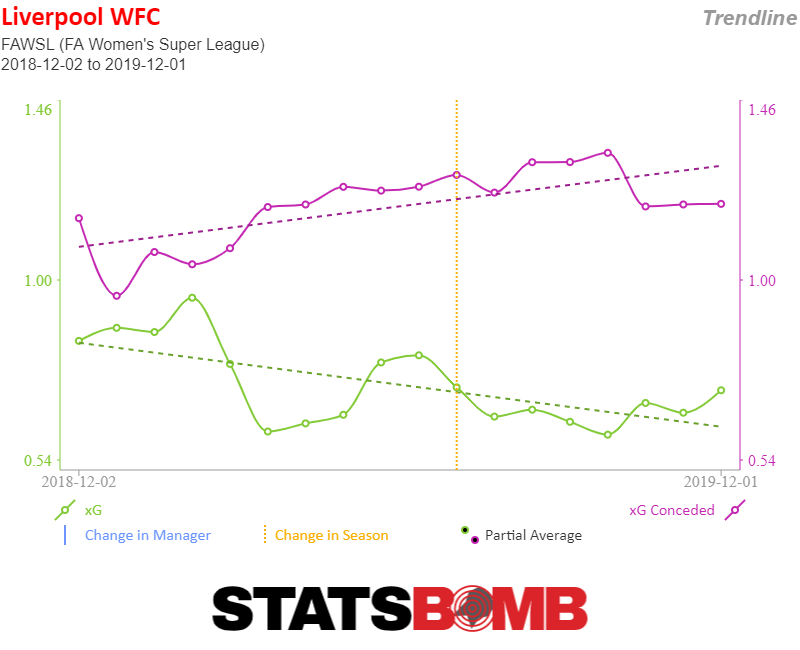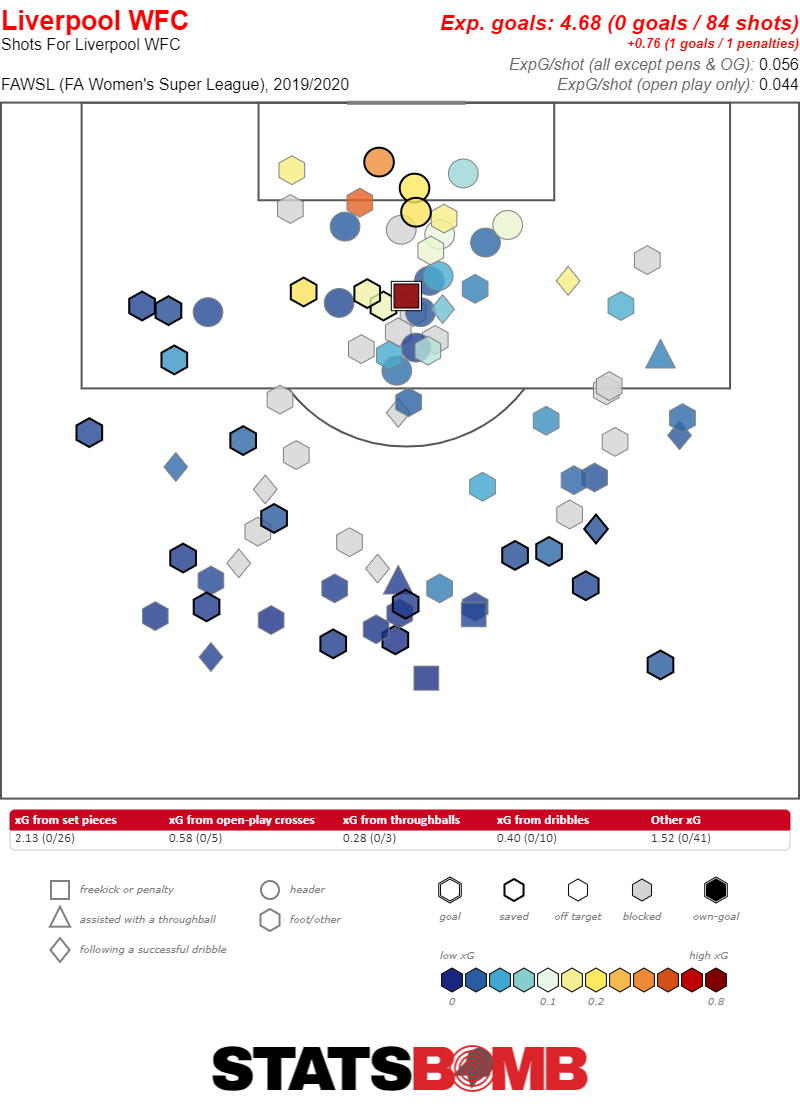There comes a time for any team where the number of points you’ve managed to accumulate in a season has gone beyond frustrating to just embarrassing, where opposition fans are looking at you in sympathy and speaking in hushed tones reserved for funerals, where conversations are entirely focused on what’s going wrong because there’s nothing else to focus on. But as the great football commentator and hobbyist poet, Robert Frost, declared, “Sometimes the coverage of teams in crisis—much like roads in a wood—diverge and we should really take a look at why”. How do you quantify a crisis, though? A team underperforming on their expected goals in every game of the season probably is cause for some consternation. A team that consistently loses possession and concedes goals without scoring any of their own should raise alarm bells. A mid-table team slipping to the bottom of the league would likely warrant concern, but maybe not as much as a team that routinely finishes in the top four doing the same. When a team that’s won the league twice in the last decade is firmly in last, with a single goal and a single point to their name, we’ve probably moved past concern and are sitting firmly in crisis territory. So why isn’t anyone wringing their hands over Liverpool Women? There’s really no arguing that Liverpool Women are in dire straits. In their last eight matches, they’ve managed to score one goal (a penalty) in the only game in which they picked up a point. The stark differences in trendlines for expected goals and expected goals conceded this season do nothing to assuage the panic or convince us that this is “just a slow start to the season”, especially because there’s no sign that the club believes there’s any cause to panic (we’ll come back to this later).  It’s difficult to pinpoint what exactly has gone wrong for Liverpool Women over the last two seasons because there’s just so much terribleness to choose from. Take the most basic aspect of scoring a goal: it’s not like Liverpool aren’t taking shots. It’s that the shots they’re able to take are either off-target or relatively easy to save.
It’s difficult to pinpoint what exactly has gone wrong for Liverpool Women over the last two seasons because there’s just so much terribleness to choose from. Take the most basic aspect of scoring a goal: it’s not like Liverpool aren’t taking shots. It’s that the shots they’re able to take are either off-target or relatively easy to save.  The few shots with a higher xG than 10% saw the opposition goalkeeper close to optimal position, as well as several opposition players in place to prevent scoring on a rebound. More than that, though, Liverpool strikers have rarely found the support they need in the box. Even the one exception this season fell short: Kirsty Linnett’s shot on goal against Birmingham forced an excellent save from Hannah Hampton and Rhiannon Roberts was quick to take a shot again from the rebound. Both shots caught Hampton just out of optimal position, but neither were able to actually score.
The few shots with a higher xG than 10% saw the opposition goalkeeper close to optimal position, as well as several opposition players in place to prevent scoring on a rebound. More than that, though, Liverpool strikers have rarely found the support they need in the box. Even the one exception this season fell short: Kirsty Linnett’s shot on goal against Birmingham forced an excellent save from Hannah Hampton and Rhiannon Roberts was quick to take a shot again from the rebound. Both shots caught Hampton just out of optimal position, but neither were able to actually score. 
 So, while it’s true that Liverpool are underperforming against expectations, it’s also true that the shots they’re generating are simply not good enough. Even the club’s top goalscorer hasn’t been able to find the back of the net. And despite Liverpool being excellent at putting pressure on opponents and better than average at pressuring ball-holding opponents to win the ball, they’ve yet to see a single clean sheet in the WSL this season.
So, while it’s true that Liverpool are underperforming against expectations, it’s also true that the shots they’re generating are simply not good enough. Even the club’s top goalscorer hasn’t been able to find the back of the net. And despite Liverpool being excellent at putting pressure on opponents and better than average at pressuring ball-holding opponents to win the ball, they’ve yet to see a single clean sheet in the WSL this season.  At this point in the season (again: eight games in, one goal scored and one point gained), surely it’s time for a conversation on what exactly needs to be done to make the ball go into the net. Because here’s the thing: if something doesn’t happen pretty soon, Liverpool Women are going to be relegated to the Championship. And for a club that’s gone on (and on and on and on) about how this is one club and two teams, it won’t look great when the men’s side have been given absolutely everything they need to win the league and maybe retain the Champions League title, too. Those of us that do regularly wring our hands over Liverpool Women and just how terrible everything is have a laundry list of very simple requests (we also have a support group). We’ll take anything from investing just a tiny bit more money into the club (we’re not asking to be in the running to sign Sam Kerr but maybe a coach with some ideas about creating better chances would come in handy at this point?) to allowing the women access to the same training facilities at the men. The fact that Liverpool Women’s fans have to beg for basic resources that the club already has is particularly egregious when you look at every other big club and the amount they’ve invested into their women’s teams. Want to see how effective investing resources into a women’s side can be? Take a look at Manchester United Women, a newly promoted team coached by a former Red and featuring several former Liverpool players who are absolutely thriving at a club that is supporting them. And at the end of the day, that’s the real crisis here. Somehow the level of panic and agitation we see when teams like Arsenal Men or Everton Men start losing games, when they consistently underperform, when their star players start talking about leaving the team, just isn’t present in conversations about Liverpool Women. We’re not seeing any mainstream critical analysis of where the team is falling short. At some point the conversation needs to move beyond demands to support the team despite their struggles and rather towards the well worn sporting topic of what should be done to fix those struggles. Liverpool Women are a professional football team that are in a bad situation, but not an irreversible one. Treating them as anything but is doing them a disservice. A lack of discussion could well lead to relegation, and even more players and staff leaving for teams willing to have difficult conversations and address the problems those bring to light.
At this point in the season (again: eight games in, one goal scored and one point gained), surely it’s time for a conversation on what exactly needs to be done to make the ball go into the net. Because here’s the thing: if something doesn’t happen pretty soon, Liverpool Women are going to be relegated to the Championship. And for a club that’s gone on (and on and on and on) about how this is one club and two teams, it won’t look great when the men’s side have been given absolutely everything they need to win the league and maybe retain the Champions League title, too. Those of us that do regularly wring our hands over Liverpool Women and just how terrible everything is have a laundry list of very simple requests (we also have a support group). We’ll take anything from investing just a tiny bit more money into the club (we’re not asking to be in the running to sign Sam Kerr but maybe a coach with some ideas about creating better chances would come in handy at this point?) to allowing the women access to the same training facilities at the men. The fact that Liverpool Women’s fans have to beg for basic resources that the club already has is particularly egregious when you look at every other big club and the amount they’ve invested into their women’s teams. Want to see how effective investing resources into a women’s side can be? Take a look at Manchester United Women, a newly promoted team coached by a former Red and featuring several former Liverpool players who are absolutely thriving at a club that is supporting them. And at the end of the day, that’s the real crisis here. Somehow the level of panic and agitation we see when teams like Arsenal Men or Everton Men start losing games, when they consistently underperform, when their star players start talking about leaving the team, just isn’t present in conversations about Liverpool Women. We’re not seeing any mainstream critical analysis of where the team is falling short. At some point the conversation needs to move beyond demands to support the team despite their struggles and rather towards the well worn sporting topic of what should be done to fix those struggles. Liverpool Women are a professional football team that are in a bad situation, but not an irreversible one. Treating them as anything but is doing them a disservice. A lack of discussion could well lead to relegation, and even more players and staff leaving for teams willing to have difficult conversations and address the problems those bring to light.
2019
Does anybody care enough to make Liverpool Women better?
By admin
|
December 4, 2019
